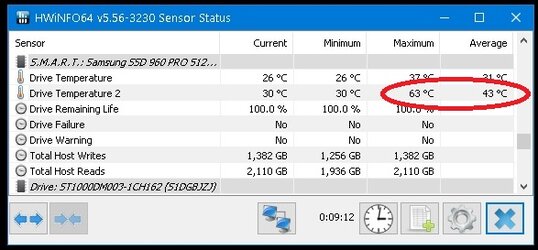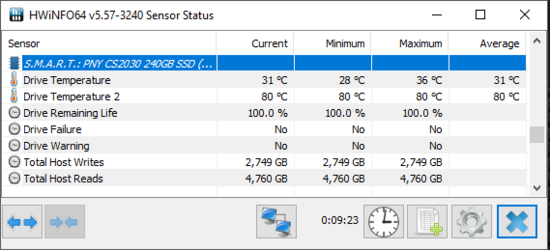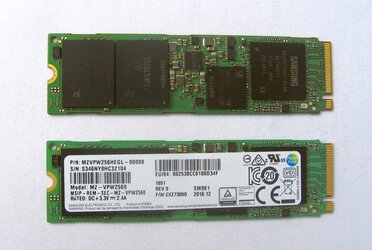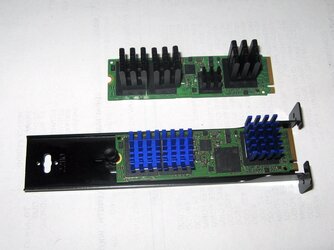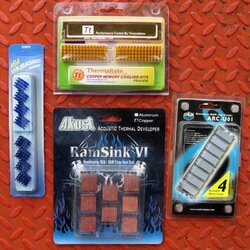- Joined
- Jan 12, 2001
- Location
- Kansas, USA
Taming the wild M.2 NVMe PCIe 3.0 X4 SSD
Or, how to keep your high speed M.2 drive happy and cool.
Introduction:
That’s a mouthful of abbreviations--here's what it means: M.2 is the new form factor of a small and fast version of the solid-state drives (SSD). NVMe stands for Non-Volatile Memory express. This drive utilizes the PCI-express (version 3.0) and can use up to four lanes (X4) of this bus.
Photo 1: M.2 drive is about the size of a stick of gum. They are small and fast and can get hot (not my photo).

I first learned of this type of “hard” drive earlier this summer. Laptops were the first to utilize the M.2 drives, but the high performance desktop folks were quick to jump in too. I know SSDs (both SATA 2.5” and especially the M.2 NVMe) are currently below the radar of the average consumer, but my batty senses tell me SSD will soon be the way of the future.
Photo 2 comparing HDD vs. 2.5" SSD vs. M.2 SSD; yesterday, today, and tomorrow (photo and witty title borrowed from cyber space)

Most people know that internal solid state drives come in two primary flavors: 2.5" SATA and M.2 NVMe. Both styles of SSD have pros and cons. I will limit discussion here to the M.2 NVMe SSD.
The M.2 is 22mm in width, but the length can be variable (a common size is 80mm long). Most M.2 connectors will allow different lengths. To make it more confusing, there are different M.2 sockets (i.e. "B key" and "M key"). Many M.2 drives are keyed to fit in either B or M key sockets. M key allows up to 4 lanes on the PCIe bus while B key restricts you to a maximum of 2 lanes. Go with the M Key and X4 lanes of PCIe, not the neutered B key.
Another thing to remember, just because the NVMe SSD drive is capable of using X4 lanes on the PCIe bus, doesn’t mean it will have 4 lanes available (depending on what motherboard is being used and how it’s configured).
Keep it cool
These small drives are fast, but can get very hot unless you take some precautions. This article documents what I did to my Samsung 960 Pro. Mainly, I'm gathering my previously posted photos and notes that are scattered throughout the forum.
I bought a Samsung 960 Pro 512GB to use as a boot drive for my new system I was building. I heard the gossip and read the reviews. The 960 Pro was the fastest and also one of the hottest. Heck, I've had years of experience cooling electronic components, no problem. Right?
I dug through my box of cooling junk and found an unused RAM sink kit made by Thermaltake (years ago). I used the 0.5mm thermal pad that came with it and stuck it onto the Samsung label. Later I copied Nebulous and used zip ties to secure the sink even better.
On the Samsung, the label has copper in it and they designed the label to act as sort of a heatsink (supposedly runs 30% cooler with this special label on). I left it on, for that reason and also I didn't want to void the warranty. I found out that Nebulous had independently found the same type of heatsink and installed it on his drive. I don't mean to imply you have to use this same exact sink, I'm just showing you what I did. Maybe it'll give you an idea for something similar or spur a brainstorm for something totally different.
Photo of my M.2 drive with sink attached, installed onto the motherboard (yellow circled area is the M.2 drive and heatsink).

Check out this article, it has thermal images of the drive during operation and it's blazing hot, especially the controller (close to the edge contacts).
http://www.guru3d.com/articles-pages/samsung-960-evo-m-2-1tb-nvme-ssd-review,7.html
I wish that I had "before" data, but I installed the sink during the build and installation. I've heard of people getting temps up into the 70s and even approaching 80 degrees. With the sink attached and passive cooling (no fan attached to the sink), I saw a max load temp of about 66 degrees C. during the CrystalDiskMark benchmark. There are two SMART temperature sensors on these M.2 drives. The most important one is the hotter of the two (labeled "drive temperature 2"). That will be the thermistor closest to the controller. It's my understanding you'll begin to get thermal throttling at about 70 degrees C. My goal is to stay below 60 if possible.
I have decent case ventilation, so I initially ran the drive with just a passive heatsink. Later, I tried putting various fans on top of the heatsink (or as close as possible) to make it active cooling. A loud, high-speed fan cooled the drive down several more degrees (probably because air was being forced under the drive to cool the backside). But, tiny low speed fans did nothing, because they didn't flow much air. (see pic).

Results summary (max load temp on sensor #2 during the CrystalDiskMark benchmark using HWiNFO64 to monitor temps.)
960 Pro with no heatsink = not tested
960 Pro with heatsink attached onto label with thermal pad = 66
960 Pro with passive heatsink and improved case ventilation = 64
960 Pro with low noise 2 X 25mm fans = no difference
960 Pro with low speed 40mm fan = 63
960 Pro with high speed 40mm fan (7,500 rpm, ear bleed loud) = 58
960 Pro with high speed 40mm fan (6,000 rpm, louder than I like) = 60
960 Pro with high speed 40mm fan (5,000 rpm, a bit loud, but tolerable) = 62
I tried the active cooling thing for a while, but didn't like the extra noise or how it looked (40mm fan is too big for the heatsink). I decided the passive heatsink was good enough after monitoring normal operational temps for a few days (temps average in the 40s to 50s under load). One other note, I pulled the drive out and tried to remove the heatsink to test it without mods, but that thermal pad I used sticks better than I thought. Not wanting to cause damage, I decided to leave well enough alone.
Here's a link to see what Nebulous did with his drive:
http://www.overclockers.com/forums/showthread.php/783352-Cooling-a-HOT-M2-NVMe-drive
Sentential talked about getting this to try. Not sure if he ever did or not. Looks nice, but not sure how well it'll cool.
https://www.ekwb.com/shop/water-blocks/ssd-blocks/m2-heatsinks
That about wraps it up. What's your reward for running a cool M.2? Longevity and blazing fast speed. Here are the results from CrystalDiskMark for my Samsung 960 Pro SSD drive:

Let's compare that to my Samsung 850 EVO 2.5" SATA SSD:

Guess I need to run the benchmark on my HDD too (Seagate Barracuda 7200 RPM hard disk drive).

Wow, look at those scores and tell me which drive you'd rather have?
If I left anything out, let me know. If there is something else I can test for you, let me know.
The second part of this article will be called Bat's How To: Unleashing the Wild M.2 SSD (I will post it in a separate thread).
This ends Bat's How To: Taming the Wild M.2 SSD
Or, how to keep your high speed M.2 drive happy and cool.
Introduction:
That’s a mouthful of abbreviations--here's what it means: M.2 is the new form factor of a small and fast version of the solid-state drives (SSD). NVMe stands for Non-Volatile Memory express. This drive utilizes the PCI-express (version 3.0) and can use up to four lanes (X4) of this bus.
Photo 1: M.2 drive is about the size of a stick of gum. They are small and fast and can get hot (not my photo).
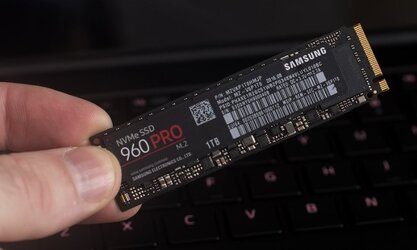
I first learned of this type of “hard” drive earlier this summer. Laptops were the first to utilize the M.2 drives, but the high performance desktop folks were quick to jump in too. I know SSDs (both SATA 2.5” and especially the M.2 NVMe) are currently below the radar of the average consumer, but my batty senses tell me SSD will soon be the way of the future.
Photo 2 comparing HDD vs. 2.5" SSD vs. M.2 SSD; yesterday, today, and tomorrow (photo and witty title borrowed from cyber space)
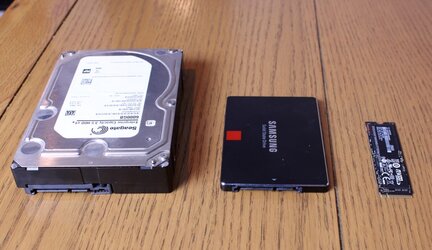
Most people know that internal solid state drives come in two primary flavors: 2.5" SATA and M.2 NVMe. Both styles of SSD have pros and cons. I will limit discussion here to the M.2 NVMe SSD.
The M.2 is 22mm in width, but the length can be variable (a common size is 80mm long). Most M.2 connectors will allow different lengths. To make it more confusing, there are different M.2 sockets (i.e. "B key" and "M key"). Many M.2 drives are keyed to fit in either B or M key sockets. M key allows up to 4 lanes on the PCIe bus while B key restricts you to a maximum of 2 lanes. Go with the M Key and X4 lanes of PCIe, not the neutered B key.
Another thing to remember, just because the NVMe SSD drive is capable of using X4 lanes on the PCIe bus, doesn’t mean it will have 4 lanes available (depending on what motherboard is being used and how it’s configured).
Keep it cool
These small drives are fast, but can get very hot unless you take some precautions. This article documents what I did to my Samsung 960 Pro. Mainly, I'm gathering my previously posted photos and notes that are scattered throughout the forum.
I bought a Samsung 960 Pro 512GB to use as a boot drive for my new system I was building. I heard the gossip and read the reviews. The 960 Pro was the fastest and also one of the hottest. Heck, I've had years of experience cooling electronic components, no problem. Right?
I dug through my box of cooling junk and found an unused RAM sink kit made by Thermaltake (years ago). I used the 0.5mm thermal pad that came with it and stuck it onto the Samsung label. Later I copied Nebulous and used zip ties to secure the sink even better.
On the Samsung, the label has copper in it and they designed the label to act as sort of a heatsink (supposedly runs 30% cooler with this special label on). I left it on, for that reason and also I didn't want to void the warranty. I found out that Nebulous had independently found the same type of heatsink and installed it on his drive. I don't mean to imply you have to use this same exact sink, I'm just showing you what I did. Maybe it'll give you an idea for something similar or spur a brainstorm for something totally different.
Photo of my M.2 drive with sink attached, installed onto the motherboard (yellow circled area is the M.2 drive and heatsink).
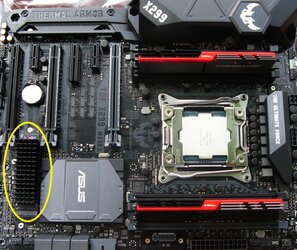
Check out this article, it has thermal images of the drive during operation and it's blazing hot, especially the controller (close to the edge contacts).
http://www.guru3d.com/articles-pages/samsung-960-evo-m-2-1tb-nvme-ssd-review,7.html
I wish that I had "before" data, but I installed the sink during the build and installation. I've heard of people getting temps up into the 70s and even approaching 80 degrees. With the sink attached and passive cooling (no fan attached to the sink), I saw a max load temp of about 66 degrees C. during the CrystalDiskMark benchmark. There are two SMART temperature sensors on these M.2 drives. The most important one is the hotter of the two (labeled "drive temperature 2"). That will be the thermistor closest to the controller. It's my understanding you'll begin to get thermal throttling at about 70 degrees C. My goal is to stay below 60 if possible.
I have decent case ventilation, so I initially ran the drive with just a passive heatsink. Later, I tried putting various fans on top of the heatsink (or as close as possible) to make it active cooling. A loud, high-speed fan cooled the drive down several more degrees (probably because air was being forced under the drive to cool the backside). But, tiny low speed fans did nothing, because they didn't flow much air. (see pic).
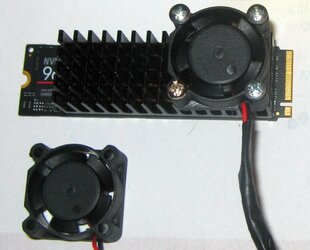
Results summary (max load temp on sensor #2 during the CrystalDiskMark benchmark using HWiNFO64 to monitor temps.)
960 Pro with no heatsink = not tested
960 Pro with heatsink attached onto label with thermal pad = 66
960 Pro with passive heatsink and improved case ventilation = 64
960 Pro with low noise 2 X 25mm fans = no difference
960 Pro with low speed 40mm fan = 63
960 Pro with high speed 40mm fan (7,500 rpm, ear bleed loud) = 58
960 Pro with high speed 40mm fan (6,000 rpm, louder than I like) = 60
960 Pro with high speed 40mm fan (5,000 rpm, a bit loud, but tolerable) = 62
I tried the active cooling thing for a while, but didn't like the extra noise or how it looked (40mm fan is too big for the heatsink). I decided the passive heatsink was good enough after monitoring normal operational temps for a few days (temps average in the 40s to 50s under load). One other note, I pulled the drive out and tried to remove the heatsink to test it without mods, but that thermal pad I used sticks better than I thought. Not wanting to cause damage, I decided to leave well enough alone.
Here's a link to see what Nebulous did with his drive:
http://www.overclockers.com/forums/showthread.php/783352-Cooling-a-HOT-M2-NVMe-drive
Sentential talked about getting this to try. Not sure if he ever did or not. Looks nice, but not sure how well it'll cool.
https://www.ekwb.com/shop/water-blocks/ssd-blocks/m2-heatsinks
That about wraps it up. What's your reward for running a cool M.2? Longevity and blazing fast speed. Here are the results from CrystalDiskMark for my Samsung 960 Pro SSD drive:
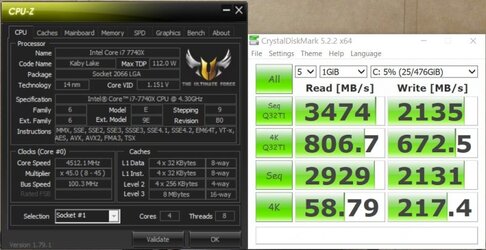
Let's compare that to my Samsung 850 EVO 2.5" SATA SSD:
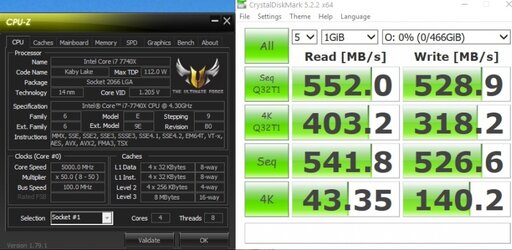
Guess I need to run the benchmark on my HDD too (Seagate Barracuda 7200 RPM hard disk drive).
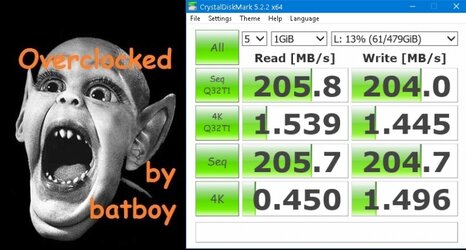
Wow, look at those scores and tell me which drive you'd rather have?
If I left anything out, let me know. If there is something else I can test for you, let me know.
The second part of this article will be called Bat's How To: Unleashing the Wild M.2 SSD (I will post it in a separate thread).
This ends Bat's How To: Taming the Wild M.2 SSD
Last edited:

